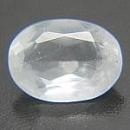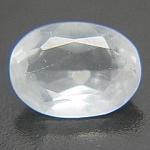|
|
||||||||||||||||
|
||||||||||||||||
|
||||||
|
|
|
|
Colemanite
|
|
| | |
| Discovered in 1884; IMA status: Valid (pre-IMA; Grandfathered) | ||
|
| ||
|
Chemistry |
|
|
| |
|
Ca2B6O11 · 5(H2O) | |
|
|
Hydrated Calcium Borate |
|
Molecular Weight: |
411.09 gm |
|
Composition: |
Calcium |
19.50 % |
Ca |
27.28 % |
CaO |
|
|
Boron |
15.78 % |
B |
50.81 % |
B2O3 |
|
|
Hydrogen |
2.45 % |
H |
21.91 % |
H2O |
|
|
Oxygen |
62.27 % |
O |
|
|
|
|
|
100.00 % |
|
100.00 % |
= TOTAL OXIDE |
|
|
|
||||
|
Classification |
|
|
| |
|
Borates | |
|
5/J.03-10 | |
|
|
6 : BORATES
|
|
Related to: |
Colemanite-Hydroboracite Series. |
|
Varieties: |
None |
|
Synonyms: |
Borspar, Neocolemanite |
|
|
|
|
Crystal Data |
|
|
|
|
|
As equant to short prismatic crystals, with large and multiple terminating forms, to 30 cm; pseudorhombohedral and pseudo-octahedral; nearly 50 forms measured; cleavable massive, granular, most commonly nodular. |
|
|
None |
|
|
|
|
|
Physical Properties |
|
|
|
|
|
Perfect on [010], Distinct on [001] |
|
|
Irregular/Uneven to Sub-Conchoidal |
|
|
Brittle |
|
|
4.5 |
|
|
2.423 (g/cm3) |
|
|
Fluorescent; bright pale yellow under SW UV and LW UV. May phosphoresce pale green. |
|
|
Not Radioactive |
|
|
Other: |
Pyroelectric
and Piezoelectric
at very low temperatures. |
|
|
|
|
Optical Properties |
|
|
|
|
|
Colorless, gray, gray white, yellowish white, white |
|
|
Transparent to Translucent |
|
|
Vitreous to Adamantine |
|
|
1.586 - 1.614 Biaxial ( + ) |
|
|
0.0280 |
|
|
Relatively weak; r > v |
|
|
None |
|
|
|
|
|
Occurances |
|
|
|
|
|
Geological Setting: |
A common constituent in borate deposits formed in arid alkaline lacustrine environments, deficient in sodium and carbonate, typically under warm conditions. |
|
Common Associations: |
Calcite, Celestine, Ginorite, Gowerite, Gypsum, Howlite, Kernite, Lüneburgite, Nobleite, Priceite, Searlesite, Ulexite |
|
Common Impurities: |
None |
|
Type Locality: |
Furnace Creek District, Death Valley, Inyo Co., California, USA |
|
Year Discovered: |
1884 |
|
View mineral photos: | |
|
|
|
|
More Information |
|
|
|
|
|
| |
|
|
|
|
Colemanite is a complex borate mineral, and like other borates, it is found in playa lakes and other evaporite deposits. Colemanite is an ore of boron and a source of borax which is a cleaning agent and useful industrial chemical. Current sources
of Colemanite are Yermo, Boron, Death Valley and other California localities, USA; Chile; and Panderma, Turkey.
|
|
|
|||||||||||||||||||||||||||


